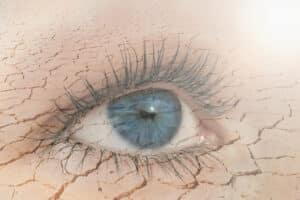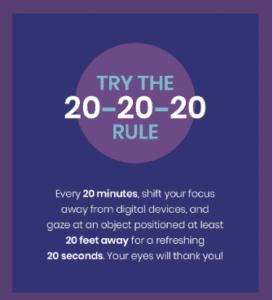What Causes Dry Eye?

What Causes Dry Eye?
Millions of people have ocular discomfort, redness, excessive tearing and/or a gritty sensation in their eyes – a condition known as dry eye syndrome. If you experience these issues, you’re not alone. But what causes dry eye?
Understanding the causes of dry eye is key to finding relief through effective management of the disease. In this blog post we will explore the primary contributing factors of dry eye, thus shedding light on the factors that may be causing your dry eye. After gaining insights into these causes, you will be able to take proactive steps to find relief from the discomfort of dry eye while also safeguarding your ocular health.
Are environmental factors causing your dry eye?
Environmental factors can absolutely play a significant role in the development of dry eye. When we are encountering low humidity, windy conditions, air conditioning or force-air heat, tears tend to evaporate quicker. When we spend hours of our day in dry offices, airplanes or a dry climate, dry patches can develop on your cornea, thus exacerbating dry eye symptoms. Ocular lubricants such a high-quality artificial tears (NOT Visene) are an obvious intervention. Wrap-around sunglasses can help in windy conditions, and may of our patients benefit from having a humidifier running in their bedroom, or even a small one at their desk.
Increased age and hormonal changes could also be causing your dry eye.
Studies have shown that tear production (and often tear quality) decrease as we age. This is particularly true for postmenopausal women, because these hormonal changes directly effect tear gland function. Tear film stability (quality) can also suffer as we age. The aging process can lead to reduced oil production in the meibomian glands in our lids, resulting in reduced tear stability (quicker tear evaporation). Getting regular eye exams with a doctor who knows how to manage dry eye, using a good artificial tear, and making some lifestyle adjustments (such as staying hydrated) can help manage the dry eye symptoms associated with aging.
Digital Eye Strain may be one of your causes of dry eye
It turns out we did not evolve around computers, and our human visual system is not optimized for staring at a nearby lighted box for hours at a time. Yet in today’s high-tech world, many of us spend several hours per day looking at screens…especially when we include time on your phone. Multiple studies have shown that our blink rate goes way down when doing intense tasks on screen. Without lots of good quality blinks, our eyes get dry.
Excessive screen time can lead to digital eye strain, which is a fatigue and aching in or around the eyes. This eye strain in combination with dryness from inadequate blinking is known as “computer vision syndrome”.
Bringing your screen intensity down or using blue-light limiting glasses or apps can help with the eye strain piece. A great rule of thumb for how often to take breaks is the 20-20-20 rule: (look away from your screen every 20 minutes at something 20 feet away for at least 20 seconds) helps quite a bit. Dr. Mark Cannon asks his patients to do 10 good blinks with the lids squeezing together during the breaks. It can often be easiest to take these brief breaks if you set up your workstation near a window.

Medications and medical conditions:
Some over-the-counter and Rx medications such as antihistamines, decongestants, antidepressants, and hormone replacement treatments can cause dry eye by disrupting tear production. Some medical conditions such as thyroid disorders, diabetes, many autoimmune diseases (including Sjogren’s syndrome) can contribute to dry eye issues. If you think your medical condition or medication may be causing your dry eye to worsen, consult with your physician to discuss alternate treatments.
Eyelid problems and eye anatomy may contribute to your dry eye.
Abnormalities in the way we blink or the anatomical structure of the lids can impact our tear production and contribute to dry eye. Deformations of the lids such as ectropion, where the lower lids flops open, or entropion, where the eyelid turns inward, can lead to insufficient tear coverage or a huge over-production of tears that run down the cheeks.
Many patients don’t blink well, which can cause poor tear coverage and a clogging of the meibomian glands in your lid. Problems with these oil glands contributes to 86% of dry eye cases, and can also lead to sties or, eventually, atrophy of the glands (gland death). Many patients need an advanced artificial tear to provide relief. Yet we can get to the root of the oil gland issue by doing a warm compress/lid-massage and blinking more deliberately. Some patients also need thermal gland expression, which we offer at our Pike Place location.
Dry eye is an uncomfortable and increasingly common eye condition that can impact your quality of life significantly. Understanding the causes of dry eye can help us take proactive steps to manage our risk and mitigate it’s symptoms. This complex web of factors, including the environment, the ageing process, digital screen use, medications, and eyelid issues contributes to the complex puzzle that is dry eye.
Working closely with knowledgeable eye doctors…and doing the at-home treatments they prescribe, we can rescue our eyes from the discomfort of dry eye by restoring a healthy homeostasis to the ocular surface. If you are experiencing severe or persistent dry eye issues, it’s crucial to consult with an eye care specialist for the right diagnosis and your personalized treatment plan.

What Causes Dry Eye?
Millions of people have ocular discomfort, redness, excessive tearing and/or a gritty sensation in their eyes – a condition known as dry eye syndrome. If you experience these issues, you’re not alone. But what causes dry eye?
Understanding the causes of dry eye is key to finding relief through effective management of the disease. In this blog post we will explore the primary contributing factors of dry eye, thus shedding light on the factors that may be causing your dry eye. After gaining insights into these causes, you will be able to take proactive steps to find relief from the discomfort of dry eye while also safeguarding your ocular health.
Are environmental factors causing your dry eye?
Environmental factors can absolutely play a significant role in the development of dry eye. When we are encountering low humidity, windy conditions, air conditioning or force-air heat, tears tend to evaporate quicker. When we spend hours of our day in dry offices, airplanes or a dry climate, dry patches can develop on your cornea, thus exacerbating dry eye symptoms. Ocular lubricants such a high-quality artificial tears (NOT Visene) are an obvious intervention. Wrap-around sunglasses can help in windy conditions, and may of our patients benefit from having a humidifier running in their bedroom, or even a small one at their desk.
Increased age and hormonal changes could also be causing your dry eye.
Studies have shown that tear production (and often tear quality) decrease as we age. This is particularly true for postmenopausal women, because these hormonal changes directly effect tear gland function. Tear film stability (quality) can also suffer as we age. The aging process can lead to reduced oil production in the meibomian glands in our lids, resulting in reduced tear stability (quicker tear evaporation). Getting regular eye exams with a doctor who knows how to manage dry eye, using a good artificial tear, and making some lifestyle adjustments (such as staying hydrated) can help manage the dry eye symptoms associated with aging.
Digital Eye Strain may be one of your causes of dry eye
It turns out we did not evolve around computers, and our human visual system is not optimized for staring at a nearby lighted box for hours at a time. Yet in today’s high-tech world, many of us spend several hours per day looking at screens…especially when we include time on your phone. Multiple studies have shown that our blink rate goes way down when doing intense tasks on screen. Without lots of good quality blinks, our eyes get dry.
Excessive screen time can lead to digital eye strain, which is a fatigue and aching in or around the eyes. This eye strain in combination with dryness from inadequate blinking is known as “computer vision syndrome”.
Bringing your screen intensity down or using blue-light limiting glasses or apps can help with the eye strain piece. A great rule of thumb for how often to take breaks is the 20-20-20 rule: (look away from your screen every 20 minutes at something 20 feet away for at least 20 seconds) helps quite a bit. Dr. Mark Cannon asks his patients to do 10 good blinks with the lids squeezing together during the breaks. It can often be easiest to take these brief breaks if you set up your workstation near a window.

Medications and medical conditions:
Some over-the-counter and Rx medications such as antihistamines, decongestants, antidepressants, and hormone replacement treatments can cause dry eye by disrupting tear production. Some medical conditions such as thyroid disorders, diabetes, many autoimmune diseases (including Sjogren’s syndrome) can contribute to dry eye issues. If you think your medical condition or medication may be causing your dry eye to worsen, consult with your physician to discuss alternate treatments.
Eyelid problems and eye anatomy may contribute to your dry eye.
Abnormalities in the way we blink or the anatomical structure of the lids can impact our tear production and contribute to dry eye. Deformations of the lids such as ectropion, where the lower lids flops open, or entropion, where the eyelid turns inward, can lead to insufficient tear coverage or a huge over-production of tears that run down the cheeks.
Many patients don’t blink well, which can cause poor tear coverage and a clogging of the meibomian glands in your lid. Problems with these oil glands contributes to 86% of dry eye cases, and can also lead to sties or, eventually, atrophy of the glands (gland death). Many patients need an advanced artificial tear to provide relief. Yet we can get to the root of the oil gland issue by doing a warm compress/lid-massage and blinking more deliberately. Some patients also need thermal gland expression, which we offer at our Pike Place location.
Dry eye is an uncomfortable and increasingly common eye condition that can impact your quality of life significantly. Understanding the causes of dry eye can help us take proactive steps to manage our risk and mitigate it’s symptoms. This complex web of factors, including the environment, the ageing process, digital screen use, medications, and eyelid issues contributes to the complex puzzle that is dry eye.
Working closely with knowledgeable eye doctors…and doing the at-home treatments they prescribe, we can rescue our eyes from the discomfort of dry eye by restoring a healthy homeostasis to the ocular surface. If you are experiencing severe or persistent dry eye issues, it’s crucial to consult with an eye care specialist for the right diagnosis and your personalized treatment plan.
Pike Place Office
1906 Pike Pl Unit 8-b,
Seattle, WA 98101
University Village Office
2602 NE University Village St,
Seattle, WA 98105
Pike Place Office Hours
Monday
Closed
Tuesday
10:00 am - 5:00 pm
Wednesday
Closed
Thursday
10:00 am - 5:00 pm
Friday
10:00 am - 5:00 pm
Saturday
10:00 am - 5:00 pm
Sunday
Closed
University Village Office Hours
Monday
10:00 am - 6:00 pm
Tuesday
10:00 am - 6:00 pm
Wednesday
10:00 am - 6:00 pm
Thursday
10:00 am - 6:00 pm
Friday
10:00 am - 6:00 pm
Saturday
10:00 am - 6:00 pm
Sunday
Closed
